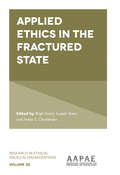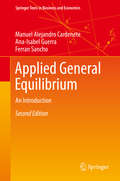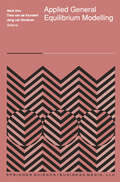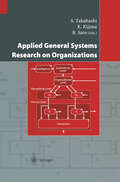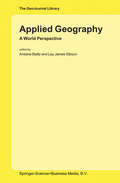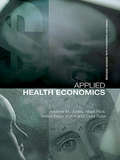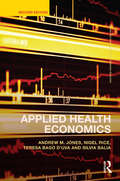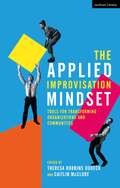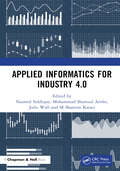- Table View
- List View
Applied Ethics in the Fractured State (Research in Ethical Issues in Organizations #20)
by Bligh Grant Joseph Drew Helen E. ChristensenThis book brings together the refereed proceedings of the 24th Annual Conference of the Australian Association of Professional and Applied Ethics (AAPAE) 'Applied Ethics in the Fractured State', held at the Institute for Public Policy and Governance, University of Technology Sydney in June 2017. The book is eclectic, with chapters on health regulation in Australia, Eastern ethical theorising (Confucianism; Buddhism), euthanasia and community engagement, all of which are examined from the unique perspective that Research in Ethical Issues in Organizations affords its contributors.
Applied Evaluative Informetrics (Qualitative and Quantitative Analysis of Scientific and Scholarly Communication)
by Henk F. MoedThis book presents an introduction to the field of applied evaluative informetrics, dealing with the use of bibliometric or informetric indicators in research assessment. It sketches the field’s history, recent achievements, and its potential and limits. The book dedicates special attention to the application context of quantitative research assessment. It describes research assessment as an evaluation science, and distinguishes various assessment models, in which the domain of informetrics and the policy sphere are disentangled analytically. It illustrates how external, non-informetric factors influence indicator development, and how the policy context impacts the setup of an assessment process. It also clarifies common misunderstandings in the interpretation of some often used statistics. Addressing the way forward, the book expresses the author’s critical views on a series of fundamental problems in the current use of research performance indicators in research assessment. Highlighting the potential of informetric techniques, a series of new features is proposed that could be implemented in future assessment processes. It sketches a perspective on altmetrics and proposes new lines in longer term, strategic indicator research. It is written for interested scholars from all domains of science and scholarship, and especially for all those subjected to research assessment, research students at advanced master and PhD level, research managers, funders and science policy officials, and to practitioners and students in the field.
Applied Financial Econometrics: Theory, Method and Applications
by Moinak MaitiThis textbook gives students an approachable, down to earth resource for the study of financial econometrics. While the subject can be intimidating, primarily due to the mathematics and modelling involved, it is rewarding for students of finance and can be taught and learned in a straightforward way. This book, going from basics to high level concepts, offers knowledge of econometrics that is intended to be used with confidence in the real world. This book will be beneficial for both students and tutors who are associated with econometrics subjects at any level.
Applied Financial Macroeconomics and Investment Strategy: A Practitioner’s Guide to Tactical Asset Allocation (Global Financial Markets)
by Robert T. McGeeThe absolute and relative performance of various asset classes is systematically related to macroeconomic trends. In this new book, Robert McGee provides a thorough guide to each stage of the business cycle and analyzes the investment implications using real-world examples linking economic dynamics to investment results.
Applied Fundamentals in Finance: Portfolio Management and Investments (Springer Texts in Business and Economics)
by Enzo MondelloThis textbook provides a comprehensive introduction to portfolio management and investments. Focusing on four core areas – portfolio management, equities, bonds, and derivatives – it is primarily intended for undergraduate and graduate students alike. However, it will also benefit practitioners working in the fields of financial analysis and portfolio management and professionals who aspire to such professional activities in the financial industry. To ensure its high practical relevance, the book includes a host of case studies and examples from real-world practice, mainly from the German and Swiss financial markets. Additionally, the book shows how to implement the models in Microsoft Excel.
Applied General Equilibrium: An Introduction (Springer Texts in Business and Economics)
by Manuel Alejandro Cardenete Ana-Isabel Guerra Ferran SanchoThis advanced textbook provides a straightforward but comprehensive introduction to applied general equilibrium modeling. General equilibrium is the backbone of modern economic analysis, which is why generation after generation of economics students have been introduced to it. As an analytical tool, general equilibrium can provide one of the most complete views of a given economy, as it incorporates all economic agents (households, firms, government and the foreign sector) in an integrated way that explicitly reveals the interplay of economic forces—supply and demand—and the balancing role of prices. Applied general equilibrium goes one step further in modeling, since it entails the integration of microeconomic theory, data handling and computing. This integration is essential for successful empirical modeling, but also involves various abilities that are not found in standard books. This book fills the gap, providing advanced students with the required tools, from the construction of consistent and applicable general equilibrium models to the interpretation of the results that ensue from the adoption of policies. This second edition expands the range of topics covered, including: indispensable general equilibrium theory, step-by-step model design, incremental model extensions, a wealth of sample computer code, procedures for constructing economic databases, database adjustments and database updating algorithms, numerical model calibration, policy strategies and their trade-offs and welfare effects, and a discussion of empirical policy examples.
Applied General Equilibrium: An Introduction (Springer Texts in Business and Economics)
by Manuel Alejandro Cardenete Ana-Isabel Guerra Ferran SanchoThis advanced textbook aims at providing a simple but fully operational introduction to applied general equilibrium. General equilibrium is the backbone of modern economic analysis and as such generation after generation of economics students are introduced to it. As an analytical tool in economics, general equilibrium provides one of the most complete views of an economy since it incorporates all economic agents (households, firms, government, foreign sector) in an integrated way that is compatible with microtheory and microdata. The integration of theory and data handling is required for successful modeling but it requires a double ability that is not found in standard books. With this book we aim at filling the gap and provide advanced students with the required tools, from the building of consistent and applicable general equilibrium models to the interpretation of the results that ensue from the adoption of policies. The topics include: model design, model development, computer code examples, calibration and data adjustments, practical policy examples.
Applied General Equilibrium (Studies in Empirical Economics)
by John Piggott John WhalleyOver the last 20 years, applied general equilibrium (AGE) modelling has developed from a small academic research program into a routinely used policy assessment tool. Major governments and international agencies maintain AGE research groups, and call for their input to a variety of trade, tax, and other resource allocation issues. This book is a collection of papers representative of recent activity in this field. Contributions have been grouped into a methodological section, a trade section, and a section on energy issues, and this division accurately indicates the focus of the volume. Readers will thus have access to up to date techniques and results currently being used by researchers at the forefront of the research program.
Applied General Equilibrium Modelling
by Henk Don Theo C. M. J. Van De Klundert Jarig Van SinderenOver the last decade or so, applied general equilibrium models have rapidly become a major tool for policy advice on issues regarding allocation and efficiency, most notably taxes and tariffs. This reflects the power of the general equilibrium approach to allocative questions and the capability of today's applied models to come up with realistic answers. However, it by no means implies that the theoretical, practical and empirical problems faced by researchers in applied modelling have all been solved in a satisfactory way. Rather, a promising field of research has been opened up, inviting theorists and practitioners to further explore and exploit its potential. The state of the art in applied general equilibrium modelling is reflected in this volume. The introductory Chapter (Part I) evaluates the use of economic modelling to address policy questions, and discusses the advantages and disadvantages of applied general equilibrium models. Three substantive issues are dealt with in Chapters 2-8: Tax Reform and Capital (Part II), Intertemporal Aspects and Expectations (Part III), and Taxes and the Labour Market (Part IV). While all parts contain results relevant for economic policy, it is clear that theory and applications for these areas are in different stages of development. We hope that this book will bring inspiration, insight and information to researchers, students and policy advisors.
Applied General Systems Research on Organizations
by S. Takahashi K. Kijima R. SatoDrastic changes of the societies in the new century require new paradigm in every area of social science. Organizations study is not exception. This book illustrates the cutting edge of organizations study beyond the traditional approaches in management science and general management theory. With an interdisciplinary approach emphasizing systemic properties of organizations such as interaction, hierarchy, network and emergence, it covers dynamic aspects of organizational learning and evolution as well as the decision making function and information processing process.
Applied Geography: A World Perspective (GeoJournal Library #77)
by Antoine BaillyApplied Geography, A World Perspective reviews progress in applied geography in different regions of the world. It does this through the eyes of an international panel of highly regarded academic practitioners. The book offers new prospects on the use of established approaches and explores exciting new territories. Together, the contributors provide a comprehensive picture of applied geography today. This book is of relevance to faculty and graduate students in the fields of geography, planning, public policy, regional science and other related social and behavioural sciences.
Applied Health Economics
by Andrew M. Jones Nigel Rice Teresa Bago D'Uva Silvia BaliaLarge-scale survey datasets, in particular complex survey designs such as panel data, provide a rich source of information for health economists. They offer the scope to control for individual heterogeneity and to model the dynamics of individual behaviour. However the measures of outcome used in health economics are often qualitative or categorical. These create special problems for estimating econometric models. The dramatic growth in computing power over recent years has been accompanied by the development of methods that help to solve these problems. This book provides a practical guide to the skills required to put these techniques into practice. This book illustrates practical applications of these methods using data on health from, among others, the British Health and Lifestyle Survey (HALS), the British Household Panel Survey (BHPS), the European Community Household Panel (ECHP) and the WHO Multi-Country Survey (WHO-MCS). Assuming a familiarity with the basic syntax and structure of Stata, this book presents and explains the statistical output using empirical case studies rather than general theory. Never before has a health economics text brought theory and practice together and this book will be of great benefit to applied economists, as well as advanced undergraduate and post graduate students in health economics and applied econometrics.
Applied Health Economics
by Andrew M. Jones Nigel Rice Teresa Bago D'Uva Silvia BaliaThe first edition of Applied Health Economics did an expert job of showing how the availability of large scale data sets and the rapid advancement of advanced econometric techniques can help health economists and health professionals make sense of information better than ever before. This second edition has been revised and updated throughout and includes a new chapter on the description and modelling of individual health care costs, thus broadening the book’s readership to those working on risk adjustment and health technology appraisal. The text also fully reflects the very latest advances in the health economics field and the key journal literature. Large-scale survey datasets, in particular complex survey designs such as panel data, provide a rich source of information for health economists. They offer the scope to control for individual heterogeneity and to model the dynamics of individual behaviour. However, the measures of outcome used in health economics are often qualitative or categorical. These create special problems for estimating econometric models. The dramatic growth in computing power over recent years has been accompanied by the development of methods that help to solve these problems. The purpose of this book is to provide a practical guide to the skills required to put these techniques into practice. Practical applications of the methods are illustrated using data on health from the British Health and Lifestyle Survey (HALS), the British Household Panel Survey (BHPS), the European Community Household Panel (ECHP), the US Medical Expenditure Panel Survey (MEPS) and Survey of Health, Ageing and Retirement in Europe (SHARE). There is a strong emphasis on applied work, illustrating the use of relevant computer software with code provided for Stata. Familiarity with the basic syntax and structure of Stata is assumed. The Stata code and extracts from the statistical output are embedded directly in the main text and explained at regular intervals. The book is built around empirical case studies, rather than general theory, and the emphasis is on learning by example. It presents a detailed dissection of methods and results of some recent research papers written by the authors and their colleagues. Relevant methods are presented alongside the Stata code that can be used to implement them and the empirical results are discussed at each stage. This text brings together the theory and application of health economics and econometrics, and will be a valuable reference for applied economists and students of health economics and applied econometrics.
Applied Health Economics
by Andrew M. Jones Nigel Rice Teresa Bago D'Uva Silvia BaliaThe first edition of Applied Health Economics did an expert job of showing how the availability of large scale data sets and the rapid advancement of advanced econometric techniques can help health economists and health professionals make sense of information better than ever before. This second edition has been revised and updated throughout and includes a new chapter on the description and modelling of individual health care costs, thus broadening the book’s readership to those working on risk adjustment and health technology appraisal. The text also fully reflects the very latest advances in the health economics field and the key journal literature. Large-scale survey datasets, in particular complex survey designs such as panel data, provide a rich source of information for health economists. They offer the scope to control for individual heterogeneity and to model the dynamics of individual behaviour. However, the measures of outcome used in health economics are often qualitative or categorical. These create special problems for estimating econometric models. The dramatic growth in computing power over recent years has been accompanied by the development of methods that help to solve these problems. The purpose of this book is to provide a practical guide to the skills required to put these techniques into practice. Practical applications of the methods are illustrated using data on health from the British Health and Lifestyle Survey (HALS), the British Household Panel Survey (BHPS), the European Community Household Panel (ECHP), the US Medical Expenditure Panel Survey (MEPS) and Survey of Health, Ageing and Retirement in Europe (SHARE). There is a strong emphasis on applied work, illustrating the use of relevant computer software with code provided for Stata. Familiarity with the basic syntax and structure of Stata is assumed. The Stata code and extracts from the statistical output are embedded directly in the main text and explained at regular intervals. The book is built around empirical case studies, rather than general theory, and the emphasis is on learning by example. It presents a detailed dissection of methods and results of some recent research papers written by the authors and their colleagues. Relevant methods are presented alongside the Stata code that can be used to implement them and the empirical results are discussed at each stage. This text brings together the theory and application of health economics and econometrics, and will be a valuable reference for applied economists and students of health economics and applied econometrics.
Applied Health Economics (Routledge Advanced Texts in Economics and Finance)
by Andrew M. Jones Nigel Rice Teresa Bago D'Uva Silvia BaliaLarge-scale survey datasets, in particular complex survey designs such as panel data, provide a rich source of information for health economists. They offer the scope to control for individual heterogeneity and to model the dynamics of individual behaviour. However the measures of outcome used in health economics are often qualitative or categorical. These create special problems for estimating econometric models. The dramatic growth in computing power over recent years has been accompanied by the development of methods that help to solve these problems. This book provides a practical guide to the skills required to put these techniques into practice. This book illustrates practical applications of these methods using data on health from, among others, the British Health and Lifestyle Survey (HALS), the British Household Panel Survey (BHPS), the European Community Household Panel (ECHP) and the WHO Multi-Country Survey (WHO-MCS). Assuming a familiarity with the basic syntax and structure of Stata, this book presents and explains the statistical output using empirical case studies rather than general theory. Never before has a health economics text brought theory and practice together and this book will be of great benefit to applied economists, as well as advanced undergraduate and post graduate students in health economics and applied econometrics.
Applied Improvisation: Leading, Collaborating, and Creating Beyond the Theatre
by Theresa Robbins Dudeck Caitlin McClureThis collection of Applied Improvisation stories and strategies draws back the curtain on an exciting, innovative, growing field of practice and research that is changing the way people lead, create, and collaborate. Applied Improvisation is the umbrella term widely used to denote the application of improvised theatre's theories, tenets, games, techniques, and exercises beyond conventional theatre spaces, to foster the growth and/or development of flexible structures, new mindsets, and a range of inter and intra-personal skills required in today's volatile and uncertain world. This edited collection offers one of the first surveys of the range of practice, featuring 12 in-depth case studies by leading Applied Improvisation practitioners and a foreword by Phelim McDermott and Lee Simpson.The contributors in this anthology are professional Applied Improvisation facilitators working in sectors as diverse as business, social science, theatre, education, law, and government. All have experienced the power of improvisation, have a driving need to share those experiences, and are united in the belief that improvisation can positively transform just about all human activity. Each contributor describes their practice, integrates feedback from clients, and includes a workbook component outlining some of the exercises used in their case study to give facilitators and students a model for their own application. This book will serve as a valuable resource for both experienced and new Applied Improvisation facilitators seeking to develop leaders and to build resilient communities, innovative teams, and vibrant organizations. For theatre practitioners, educators, and students, it opens up a new realm of practice and work.
Applied Improvisation: Leading, Collaborating, and Creating Beyond the Theatre
by Theresa Robbins Dudeck Caitlin McClureThis collection of Applied Improvisation stories and strategies draws back the curtain on an exciting, innovative, growing field of practice and research that is changing the way people lead, create, and collaborate. Applied Improvisation is the umbrella term widely used to denote the application of improvised theatre's theories, tenets, games, techniques, and exercises beyond conventional theatre spaces, to foster the growth and/or development of flexible structures, new mindsets, and a range of inter and intra-personal skills required in today's volatile and uncertain world. This edited collection offers one of the first surveys of the range of practice, featuring 12 in-depth case studies by leading Applied Improvisation practitioners and a foreword by Phelim McDermott and Lee Simpson.The contributors in this anthology are professional Applied Improvisation facilitators working in sectors as diverse as business, social science, theatre, education, law, and government. All have experienced the power of improvisation, have a driving need to share those experiences, and are united in the belief that improvisation can positively transform just about all human activity. Each contributor describes their practice, integrates feedback from clients, and includes a workbook component outlining some of the exercises used in their case study to give facilitators and students a model for their own application. This book will serve as a valuable resource for both experienced and new Applied Improvisation facilitators seeking to develop leaders and to build resilient communities, innovative teams, and vibrant organizations. For theatre practitioners, educators, and students, it opens up a new realm of practice and work.
The Applied Improvisation Mindset: Tools for Transforming Organizations and Communities
by Theresa Robbins Dudeck and Caitlin McClureHow can the practice of improvisation become the lens through which we view the world? The Applied Improvisation Mindset takes readers deep into the maturing field of Applied Improvisation (AI), with stories of 18 practitioners from five countries who embrace an improvisation mindset to create a more collaborative, equitable, sustainable, and joyous world. Myriad organizations have discovered how the mindset and skills applied by great improvisers onstage can reveal emergent, generative ways of interacting with others offstage.With case studies on developing presentation skills, reducing anxiety in teens, or preparing climate risk managers across the globe for the challenges ahead, this second volume serves as a valuable resource for both experienced and new AI facilitators. It is a primer for higher education and K-12 faculty combatting traditional teaching limitations and a practical “how to” for theatre practitioners, artists, educators, or anyone seeking to transform their organizations and communities.
The Applied Improvisation Mindset: Tools for Transforming Organizations and Communities
How can the practice of improvisation become the lens through which we view the world? The Applied Improvisation Mindset takes readers deep into the maturing field of Applied Improvisation (AI), with stories of 18 practitioners from five countries who embrace an improvisation mindset to create a more collaborative, equitable, sustainable, and joyous world. Myriad organizations have discovered how the mindset and skills applied by great improvisers onstage can reveal emergent, generative ways of interacting with others offstage.With case studies on developing presentation skills, reducing anxiety in teens, or preparing climate risk managers across the globe for the challenges ahead, this second volume serves as a valuable resource for both experienced and new AI facilitators. It is a primer for higher education and K-12 faculty combatting traditional teaching limitations and a practical “how to” for theatre practitioners, artists, educators, or anyone seeking to transform their organizations and communities.
Applied Industrial Organization: Towards a Theory-Based Empirical Industrial Organization
by Karl Aiginger Jörg FinsingerApplied Industrial Organization offers a perspective on the richness of empirical industrial organization studies. Some papers derive empirical implications from theoretical models, but other papers start from empirical evidence and construct a theory. Three major topics are explored: the role of innovation, the evolution of market structure and firms, and the determinations of performance. As the central force of market economies, innovation is the essence of competition and results in changes to market structures. Other forces driving the evolution of markets and firms are also analyzed. Finally, the determinants of profitability are investigated. In particular, characteristics such as price flexibility, successful lenders and monopoly regulation are examined. Contributors include F.M. Scherer, Paul Geroski, John Hey, David Audretsch, Manfred Neumann, among others.
Applied Informatics for Industry 4.0
by Nazmul Siddique Mohammad Shamsul Arefin Julie Wall M Shamim KaiserApplied Informatics for Industry 4.0 combines the technologies of computer science and information science to assist in the management and processing of data to provide different types of services. Due to the adaptation of 4.0 IR-related technologies, applied informatics is playing a vital role in different sectors such as healthcare, complex system design and privacy-related issues. This book focuses on cutting edge research from the fields of informatics and complex industrial systems, and will cover topics including health informatics, bioinformatics, brain informatics, genomics and proteomics, data and network security and more. The text will appeal to beginners and advanced researchers in the fields of computer science, information sciences, electrical and electronic engineering and robotics.
Applied Informatics for Industry 4.0
by Nazmul Siddique Mohammad Shamsul Arefin Julie Wall M. Shamim KaiserApplied Informatics for Industry 4.0 combines the technologies of computer science and information science to assist in the management and processing of data to provide different types of services. Due to the adaptation of 4.0 IR-related technologies, applied informatics is playing a vital role in different sectors such as healthcare, complex system design and privacy-related issues. This book focuses on cutting edge research from the fields of informatics and complex industrial systems, and will cover topics including health informatics, bioinformatics, brain informatics, genomics and proteomics, data and network security and more. The text will appeal to beginners and advanced researchers in the fields of computer science, information sciences, electrical and electronic engineering and robotics.
Applied Information Science, Engineering and Technology: Selected Topics from the Field of Production Information Engineering and IT for Manufacturing: Theory and Practice (Topics in Intelligent Engineering and Informatics #7)
by Gabriella Bognár Tibor TóthThe objective of the book is to give a selection from the papers, which summarize several important results obtained within the framework of the József Hatvany Doctoral School operating at the University of Miskolc, Hungary. In accordance with the three main research areas of the Doctoral School established for Information Science, Engineering and Technology, the papers can be classified into three groups. They are as follows: (1) Applied Computational Science; (2) Production Information Engineering (IT for Manufacturing included); (3) Material Stream Systems and IT for Logistics. As regards the first area, some papers deal with special issues of algorithms theory and its applications, with computing algorithms for engineering tasks, as well as certain issues of data base systems and knowledge intensive systems. Related to the second research area, the focus is on Production Information Engineering with special regard to discrete production processes. In the second research area the papers show some new integrated systems suitable for optimizing discrete production processes in a top-down way. The papers connecting with the third research field deal with different issues of materials stream systems and logistics, taking into consideration of applied mathematical models and IT-tools. The book makes an effort to ensure certain equilibrium between theory and practice and to show some new approach both from theoretical modelling aspect, as well as experimental and practical point of view.
Applied Information Security: A Hands-on Approach
by David Basin Patrick Schaller Michael SchläpferThis book explores fundamental principles for securing IT systems and illustrates them with hands-on experiments that may be carried out by the reader using accompanying software. The experiments highlight key information security problems that arise in modern operating systems, networks, and web applications. The authors explain how to identify and exploit such problems and they show different countermeasures and their implementation. The reader thus gains a detailed understanding of how vulnerabilities arise and practical experience tackling them.After presenting the basics of security principles, virtual environments, and network services, the authors explain the core security principles of authentication and access control, logging and log analysis, web application security, certificates and public-key cryptography, and risk management. The book concludes with appendices on the design of related courses, report templates, and the basics of Linux as needed for the assignments.The authors have successfully taught IT security to students and professionals using the content of this book and the laboratory setting it describes. The book can be used in undergraduate or graduate laboratory courses, complementing more theoretically oriented courses, and it can also be used for self-study by IT professionals who want hands-on experience in applied information security. The authors' supporting software is freely available online and the text is supported throughout with exercises.
Applied Intelligence for Industry 4.0
by Nazmul Siddique Mohammad Shamsul Arefin M. Shamim Kaiser A. S. M. KayesWe are all aware that artificial intelligence (AI) has brought a change in our lives, driven by a new form of interaction between man and machine. We are in the era of the fourth Industrial Revolution (IR) where AI plays vital roles in human development by enabling extraordinary technological advances making fundamental changes to the way we live, work and relate to one another. It is an opportunity to help everyone, including leaders, policymakers and people from all income groups and nations, to harness converging technologies in order to create an inclusive, human-centered future. We need to prepare our graduates as well as researchers to conduct their research with 4.0 IR-related technologies. We need to develop policies and implement those policies to focus on the components of 4.0 IR for sustainable developments. Applied Intelligence for Industry 4.0 will cover cutting edge topics in the fields of AI and industry 4.0. The text will appeal to beginners and advanced researchers in computer science, information sciences, engineering and robotics. Features Discusses advance data mining, feature extraction and classification algorithms for disease detection, cyber security detection and prevention, soil quality assessment and other industrial applications Includes the parameter optimization and explanation of intelligent approaches for business applications Presents context-aware smart insights and energy efficient and smart computing for the next-generation of smart industry
